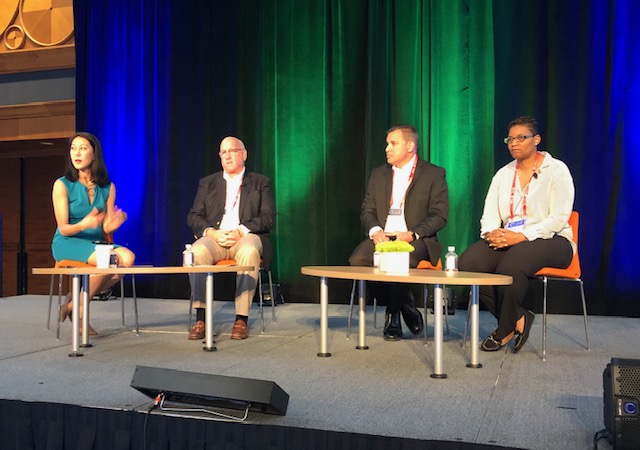High labor costs are among the top issues impacting the senior living industry. But raising wages also may help solve a host of other ills — not only improving recruitment and retention, but driving occupancy and higher rates.
The subject of a living wage was one of several actionable strategies for workforce development and retention under discussion Thursday morning during the National Investment Center for Seniors Housing & Care (NIC) fall conference in Chicago. Industry leaders from Benchmark Senior Living, Asbury Communities and Vi Living all weighed in.
A living wage is one way a provider can invest in improving the quality of its workforce, Activated Insights CEO and panel moderator Jacquelyn Kung said. Activated Insights conducts the annual Great Place to Work survey and works with Forbes on its Best Workplaces in Aging Services list.
This year’s list included input from 223,183 employees working in the U.S. senior housing and in-home care sectors. Activated Insights’ data showed that providers with improved workplace culture showed an 11% improvement in employee trust among the top quintile of providers that took the survey, as well as an 8% reduction in employee turnover.
An improved workplace culture also correlated to an average 90% occupancy rate among the top decile of providers in the survey, and a 5% increase in average rates.
Kung compared the performances of the top quintile of providers to Southwest Airlines, which began investing more in its workforce in the late 90s. That strategy has resulted in higher earnings, profits and improved stock performance.
A living wage is a key to retention at Asbury Communities. The Fredericksburg, Maryland-based nonprofit provider has a portfolio of seven communities.
No Asbury employee earns a wage that is less than what would be a living wage in a community’s market, Chief Human Resources & Compliance Officer Juan Manuel Ocasio-Colon said during the panel. At one community, paying a living wage made a huge impact on retention, with some job descriptions seeing a 60% reduction in turnover.
“A living wage is a values-based decision, versus a market-driven one,” Ocasio said.
Some providers are being more mindful of the average wage in a market, and are tracking rates within and outside senior living, Benchmark Senior Living founder, Chairman and CEO Tom Grape said. The Waltham, Massachusetts-based provider, which has a portfolio of 58 communities, does comparative market studies to measure where its communities rank in wage in its markets, and has raised the minimum wage in areas where it was lagging.
“You have to be competitive with the Walmarts and emphasize that we have a higher calling,” Grape said.
In a tight labor market, providers have realized that workers have leverage in where they choose to work, Akhira McPherson, staff development manager at Vi Living at Lakeside Village in Lantana, Florida, said. Chicago-based Vi is known for high-end CCRCs, and has a portfolio of 10 communities.
Lakeside Village looks to competitors to study what wages the market will bear, and is willing to pay a premium based on experience. Vi Living is able to retain its staff due to a solid combination of pay and benefits. That results in word of mouth which helps to establish a pipeline of new talent.
“It’s not the wage itself, but what the skillset can earn in the market,” McPherson said.
The idea of paying higher wages to reduce costs is something that runs counter to standard investor thinking. Many investors do not think about the broader employment landscape in a market when pushing back on wage hikes, and need to understand that a community is not only competing with other communities in a given market for talent, Grape said.
Private equity giant KKR recently invested in Benchmark to the tune of $1.8 billion, acquiring an ownership interest previously held by real estate investment trust Welltower (NYSE: WELL) Discussions about higher wages are ongoing and market-dependent, but Grape is insistent that Benchmark will pay a living wage to its employees.
“Our commitment is to the workers,” he said.
Asbury’s commitment to paying staff a living wage came out of what it learned from the Great Place to Work survey, Ocasio said. When the company made the commitment, its executive team took no base salary increases and agreed to performance-based incentives, instead.
“This gave everyone skin in the game,” Ocasio said.
Companies featured in this article:
Activated Insights, Asbury Communities, Benchmark Senior Living, Vi Living


